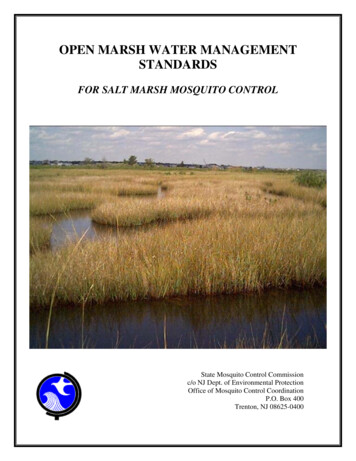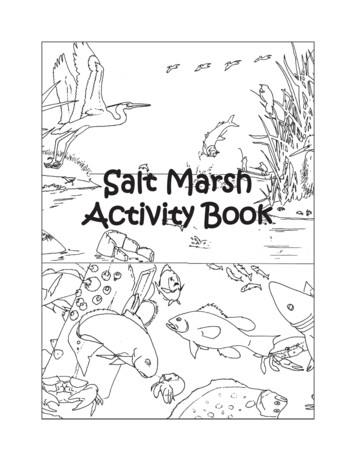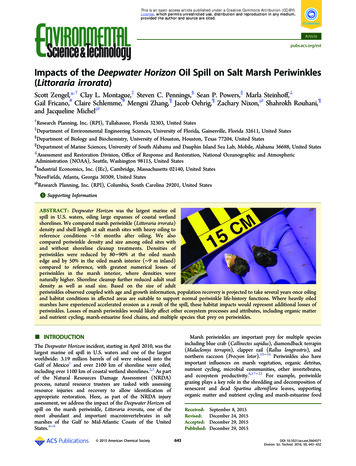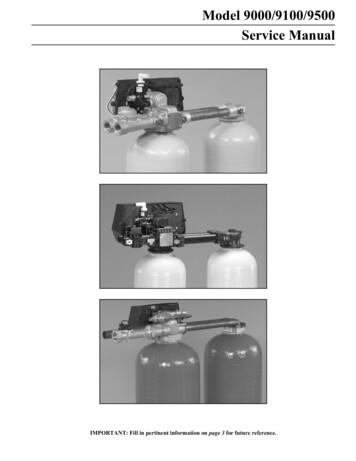
Transcription
OPEN MARSH WATER MANAGEMENTSTANDARDSFOR SALT MARSH MOSQUITO CONTROLState Mosquito Control Commissionc/o NJ Dept. of Environmental ProtectionOffice of Mosquito Control CoordinationP.O. Box 400Trenton, NJ 08625-0400
OPEN MARSH WATER MANAGEMENT STANDARDSFOR SALT MARSH MOSQUITO CONTROLNew Jersey Department of Environmental ProtectionOffice of Mosquito Control CoordinationPO Box 400Trenton, NJ 08625-0400
Table of ContentsIntroduction .Page 1“Standards for Open Marsh Water Management” .Page 2AttachmentsAttachment A – Articles from the Proceedings of the New Jersey Mosquito ControlAssociation“The establishment of unified open marsh water management standardsin New Jersey”by Dr. Kenneth W. Bruder, 1980“Open marsh water management”by Fred Ferrigno and Daniel M. Jobbins, 1968“Saltmarsh water management for mosquito control”by Fred Ferrigno, Patrick Slavin, and D. M. Jobbins, 1975“A cost comparison between open marsh water management andchemical larviciding, utilizing modern mosquito control equipment”by Richard Candeletti and Thomas M. Candeletti, 1990“The history and application of Open Marsh Water Management in NewJersey”by Richard Candeletti, 2007Attachment B – Open Marsh Water Management References
IntroductionThe Office of Mosquito Control Coordination (the Office), within the Division ofFish and Wildlife of the New Jersey Department of Environmental Protection (NJDEP),is the operational arm of the New Jersey State Mosquito Control Commission. TheOffice administers several state-aid programs to county mosquito control organizations,such as the State Airspray and State Bio-Control Programs. One of the most importantprograms administered by the Office is the State Equipment-Use Program, which allowscounties to lease state-owned equipment to supplement their mosquito control activities.One of the primary equipment needs within the state is for low-ground pressureequipment to perform water management projects, activities regulated by the NJDEPLand Use Regulation Program as well as the United States Army Corps of Engineers (incoastal locations). Water management is the most effective means to control mosquitopopulations by removing larval habitat – it is a source reduction technique thatsubstantially reduces the need to apply insecticides.Historically, the most significant problems within the state have been in coastallocations where salt marshes provide large areas of larval habitat for mosquitoproduction. Prior to the implementation of mosquito control measures many of thestate’s most important recreational and tourist destinations, such as Long Beach Islandand Atlantic City, were considered nearly uninhabitable due to the nuisance and potentialfor disease transmission associated with the large mosquito populations in these areas. Inthe 1960’s and 70’s (as a means of reducing mosquito problems as well as restoreseverely disturbed salt marsh habitat) several organizations within the state – includingthe NJDEP, Rutgers University, and county mosquito control organizations – developedand refined techniques for Open Marsh Water Management (OMWM). OMWM is a landmanagement practice that restores salt marsh habitat that has been disturbed by humanintervention through practices such as parallel grid ditching and salt hay farming to amore natural environ while increasing tidal exchange on the marsh. The practice resultsin increased habitat for a variety of fauna and effective mosquito control by introducingnatural fish predators to feed on larvae. In many locations where OMWM has beenperformed insecticide use has been rendered unnecessary.Enclosed within this document is the “Standards for Open Marsh WaterManagement”, five select articles from the Proceedings of the New Jersey MosquitoControl Association, and a list of references. The purpose of this document is to providea complete description of what OMWM is, what it is not, and what the costs and benefitsof its use are. Additional articles on the subject are available from the "Proceedings" ofthe New Jersey Mosquito Control Association, Inc. Tables of content and how to obtaincopies may be found at www.njmosquito.org.1
Standards for Open Marsh Water Management (OMWM)County mosquito commissions, Rutgers University and the New Jersey Divisionof Fish, Game and Shellfisheries have been perfecting one technique, Open Marsh WaterManagement (OMWM) for the control of all genera of salt marsh mosquitoes on opentidal marshes for over two decades. Perfection is achieved by continued improvementand evaluation. In order to ensure the finest quality and identify this managementtechnique, certain standards are a necessity. These standards should be included in anyriparian or other permit. Improper adherence to these standards would be a violation ofthe permit and infringement on the quality of the management technique. The followingstandards shall be utilized and strictly adhered to in any OMWM project:I.NEED. OMWM will be based entirely on need and utilized on breeding marshesonly.A.OMWM will be confined to the Spartina patens or mixed S. patens, shortS. alterniflora or types of similar vegetation that are irregularly flooded byrains, spring or storm tides. It will not be employed on marshes that areregularly inundated or affected by daily tides such as tall saltmarshcordgrass (Spartina alterniflora), wildrice (Zizania aquatica), cattail(Typha spp.), arrow arum (Peltandra virginica), threesquare (Scirpusolneyi) and other types of similar vegetation.B.All alterations must directly affect mosquito breeding depressions.C.The direction and type of alteration used will depend on the distribution ofthe mosquito breeding depressions and their proximity to natural pondsand tidal ditches.D.An experienced wildlife biologist, mosquito control worker, or both, shallstake out all breeding depressions ahead of the equipment. Depressionmarking shall be utilized to determine the least amount of alterationneeded to eliminate mosquito breeding.E.All mosquito or other ditches encountered that are not contributing tobreeding mosquitoes will not be cleaned.F.When possible, ponds previously altered by mosquito ditches will berestored.II.ALTERATIONS. Three types of alterations (tidal ditches, ponds and pondradials) will be used.A.Tidal Ditches1.All tidal ditches will be dug with suitable equipment, preferablywith a rotary ditcher.2.When mosquito breeding depressions are located adjacent to atidal, mosquito or other ditch, a tidal ditch alteration will beutilized.3.When a tidal ditch is dug near a pond, the spoil should bedeposited on the pond side.2
4.5.6.7.8.Attempts should be made to dig tidal ditches to a depth ofapproximately three feet. Meandering or straight ditches areacceptable.Main tidal ditches are used to provide tidal circulation throughlarge areas. They should be connected to a tidal source on bothends where possible. Their location is determined by thedistribution of breeding depressions.Lateral tidal ditches connect breeding depressions to mains, naturaltidal ditches or other laterals. Such laterals often dead-end in abreeding depression.All mosquito or other ditches that are breeding will be cleaned.Spoil shall be used whenever possible to fill adjacent mosquitobreeding depressions or spread evenly over the marsh to encouragegrowth of existing vegetation.B.Pond Radials1.All mosquito breeding depressions located near a natural or otherpermanent pond shall be connected to this pond by pond radials.These radials will provide access for fish to devour mosquito in thedepressions.2.All pond radials shall be constructed with suitable equipment,preferably with a rotary ditcher.3.To prevent drainage of a pond by muskrats or snow geese, all pondradials shall terminate at a sufficient distance from a tidal ditch.C.Ponds1.Where large numbers of mosquito breeding depressions areconcentrated in a limited area, a pond alteration will be utilized.2.Pond construction is accomplished by the use of the rotary ditcher,amphibious crane or other suitable equipment.3.Ponds should be shallow, less than one foot in depth, to promotethe best waterfowl, wading and shore bird use.4.To prevent mosquito breeding during droughts, a reservoir threefeet in depth shall be installed within the pond.5.These reservoirs should provide proper pond access by humans.When large numbers of radials are used, reservoirs areunnecessary.6.Reservoirs for fish can be ensured in natural ponds that dry outduring droughts by construction of three foot ditches with a rotaryditcher or other suitable equipment. These reservoirs will connectall the lowest areas within the pond.7.Pond spoil should be squashed and leveled without causingdepressions. It should be reduced to the lowest possible level toensure reestablishment of existing vegetation. Spoil shallapproximate the level of the existing marsh.3
8.Ponds may take the shape of the breeding area or may be squaredoff to facilitate construction. The shape of a pond or ditch does notappreciably affect wildlife use. Depth, food potential andavailability are the main factors that determine wildlife utilization.III.OBJECTIVESA.To adequately serve the three major objectives (control mosquitoes,eliminate insecticides and enhance the tidal food web) all three alterationtypes (tidal ditches, ponds and pond radials) shall be utilized on eachsection of marsh whenever possible. Diversity provides a better marshenvironment, prevents marsh surface breeding by all genera of mosquitoesand enhances both major branches of the tidal food web.B.Insecticide use is gradually phased out as OMWM progresses to eliminatebreeding acreage. When the project is completed, all insecticide useshould terminate.IV.OTHER TECHNIQUESImpoundments, stop ditches and other types of management techniquesare not OMWM.V.EVALUATIONMosquito larval dippings, vegetational plots, invertebrate sampling andwildlife censuses are to be conducted on the area treated with OMWM andcompared with a control of similar composition.4
Attachment A – Articles from the Proceedings of the New JerseyMosquito Control Association“The establishment of unified open marsh water management standards in New Jersey”by Dr. Kenneth W. Bruder, 1980“Open marsh water management”by Fred Ferrigno and Daniel M. Jobbins, 1968“Saltmarsh water management for mosquito control”by Fred Ferrigno, Patrick Slavin, and D. M. Jobbins, 1975“A cost comparison between open marsh water management and chemical larviciding,utilizing modern mosquito control equipment”by Richard Candeletti and Thomas M. Candeletti, 1990“The history and application of Open Marsh Water Management in New Jersey”by Richard Candeletti, 2007
NEW JERSEY MOSQUITO CONTROL ASSOCIATION, INC.THE ESTABLISHMENT OF UNIFIEDOPEN MARSH WATER MANAGEMENTSTANDARDS IN NEW JERSEYDr. Kenneth W. BruderOffice of Mosquito Control CoordinationN.J. Department of Environmental ProtectionTrenton, N.J. 08625As most of you are aware, mosquito control agencies here in New Jersey, as inother States, are required to obtain Army Corps of Engineer permits before commencingany water management work on our salt marshes. A major problem that often confrontedthe counties in the past, however, was the lengthy delays in the issuance of such permitsdue to the review process of the federal agencies involved.This problem may have been eliminated, or at least reduced, here in New Jersey.For through the cooperative efforts of county, state and federal personnel over the pastfew months, a set of Open Marsh Water Management Standards has been compiledwhich is acceptable to all concerned agencies.These standards have been so well accepted, in fact, that the Army Corps ofEngineer’s Permit Section has already indicated that they will be incorporated in allfuture permits for marsh management work on New Jersey’s open tidal areas. Theacceptance, and inclusion of the Open Marsh Water Management Standards in all futurepermits, will hopefully eliminate any concern the Corps has had in the past regardinginappropriate mosquito control practices on open tidal marsh areas and should help inexpediting the issuance of permits to the counties.It has taken over twenty years to develop the standards that are being discussedtoday. Ferrigno et al, (1975) listed some nine general standards for Open Marsh WaterManagement. Of special note is the fact that in the article the authors briefly mention theU.S. Fish and Wildlife Service’s interest in having coastal states establish standards forwater management for mosquito control so that such standards could be used by thefederal government in screening permit applications. This was back in 1975. To myknowledge, New Jersey is the first and only state thus far to adopt such a set of standardsdealing with mosquito control on open tidal marshes.The need to adopt a set of standards covering Open Marsh Water Managementbecame apparent this fall. In November, I was informed by the superintendents of theCape May and Cumberland County Mosquito Commissions of the fact that the Corps waswithholding county permits for Open Marsh Water Management work due to problemsthat it was having in determining what management techniques were being includedunder the term Open Marsh Water Management, as it appeared on county applicationforms.72
In response, I scheduled a meeting with representatives from the coastal countiesand the state to have them air their views on what should, or should not, be considered asacceptable techniques under Open Marsh Water Management, and to establish a set ofstandards which would be acceptable to all concerned. In attendance were Judy Hansen,Superintendent of the Cape May County Mosquito Commission; Pat Slavin, Director ofthe Cumberland County Mosquito Commission; Brian Gooley, the Supermintendent forBurlington County; Fred Lesser and Tom Candeletti from Ocean County; Harry Tillettand Dave Rizzley representing the Atlantic County Mosquito Control Agency; Mr. FredFerrigno, Senior Biologist from the New Jersey Division of Fish, Game andShellfisheries; and Dr. Joseph Shisler, Marsh Management Specialist from the NewJersey Agricultural Experiment Station. As a result of the meeting, a first draft of OpenMarsh Water Management Standards was drawn up.A second meeting was then held on December 14, with the same individuals inattendance, plus Jeff Steen and Frank Cianfrani from the Permit Section of the ArmyCorps of Engineers in Philadelphia. The standards were further reviewed and additionalamendments made. At the meeting, Mr. Steen requested that the revised standards besubmitted to the Corps’ Office in Philadelphia as quickly as possible, for final approval.This was done in early January. Since then, my office has received several letters fromrepresentatives of the Corps of Engineers and the U.S. Fish and Wildlife Serviceindicating their acceptance of the standards.I strongly believe that the Open Marsh Water Management Standards, althoughestablished primarily for work on New Jersey’s open tidal marshes, can be utilized andadopted in other states as well.At this time, I would like to briefly run through our Standards with you.STANDARDS FOR OPEN MARSH WATER MANAGEMENT (OMWM)County mosquito commissions, Rutgers University and the New Jersey Divisionof Fish, Game and Shellfisheries have been perfecting one technique; Open Marsh WaterManagement (OMWM) for the control of all genera of salt marsh mosquitoes on opentidal marshes for over two decades. Perfection is achieved by continued improvementand evaluation. In order to ensure the finest quality and identify this managementtechnique, certain standards are a necessity. These standards should be included in anyriparian or other permit. Improper adherence to these standards would be a violation ofthe permit and infringement on the quality of the management technique. The followingstandards shall be utilized and strictly adhered to in any OMWM project:I.NEED. OMWM will be based entirely on need and utilized on breeding marshesonly.A.OMWM will be confined to the Spartina patens or mixed S. patens, shortS. alterniflora or types of similar vegetation that are irregularly flooded byrains, spring or storm tides. It will not be employed on marshes that are73
B.C.D.E.F.II.regularly inundated or affected by daily tides such as tall saltmarshcordgrass (Spartina alterniflora), wildrice (Zizania aquatica), cattail(Typha spp.), arrow arum (Peltandra virginica), threesquare (Scirpusolneyi) and other types of similar vegetation.All alterations must directly affect mosquito breeding depressions.The direction and type of alteration used will depend on the distribution ofthe mosquito breeding depressions and their proximity to natural pondsand tidal ditches.An experienced wildlife biologist, mosquito control worker, or both, shallstake out all breeding depressions ahead of the equipment. Depressionmarking shall be utilized to determine the least amount of alterationneeded to eliminate mosquito breeding.All mosquito or other ditches encountered that are not contributing tobreeding mosquitoes will not be cleaned.When possible, ponds previously altered by mosquito ditches will berestored.ALTERATIONS. Three types of alterations (tidal ditches, ponds and pondradials) will be used.A.Tidal Ditches1.All tidal ditches will be dug with suitable equipment, preferablywith a rotary ditcher.2.When mosquito breeding depressions are located adjacent to atidal, mosquito or other ditch, a tidal ditch alteration will beutilized.3.When a tidal ditch is dug near a pond, the spoil should bedeposited on the pond side.4.Attempts should be made to dig tidal ditches to a depth ofapproximately three feet. Meandering or straight ditches areacceptable.5.Main tidal ditches are used to provide tidal circulation throughlarge areas. They should be connected to a tidal source on bothends where possible. Their location is determined by thedistribution of breeding depressions.6.Lateral tidal ditches connect breeding depressions to mains, naturaltidal ditches or other laterals. Such laterals often dead-end in abreeding depression.7.All mosquito or other ditches that are breeding will be cleaned.8.Spoil shall be used whenever possible to fill adjacent mosquitobreeding depressions or spread evenly over the marsh to encouragegrowth of existing vegetation.B.Pond Radials1.All mosquito breeding depressions located near a natural or otherpermanent pond shall be connected to this pond by pond radials.74
2.3.C.These radials will provide access for fish to devour mosquito in thedepressions.All pond radials shall be constructed with suitable equipment,preferably with a rotary ditcher.To prevent drainage of a pond by muskrats or snow geese, all pondradials shall terminate at a sufficient distance from a tidal ditch.Ponds1.Where large numbers of mosquito breeding depressions areconcentrated in a limited area, a pond alteration will be utilized.2.Pond construction is accomplished by the use of the rotary ditcher,amphibious crane or other suitable equipment.3.Ponds should be shallow, less than one foot in depth, to promotethe best waterfowl, wading and shore bird use.4.To prevent mosquito breeding during droughts, a reservoir threefeet in depth shall be installed within the pond.5.These reservoirs should provide proper pond access by humans.When large numbers of radials are used, reservoirs areunnecessary.6.Reservoirs for fish can be ensured in natural ponds that dry outduring droughts by construction of three foot ditches with a rotaryditcher or other suitable equipment. These reservoirs will connectall the lowest areas within the pond.7.Pond spoil should be squashed and leveled without causingdepressions. It should be reduced to the lowest possible level toensure reestablishment of existing vegetation. Spoil shallapproximate the level of the existing marsh.8.Ponds may take the shape of the breeding area or may be squaredoff to facilitate construction. The shape of a pond or ditch does notappreciably affect wildlife use. Depth, food potential andavailability are the main factors that determine wildlife utilization.III.OBJECTIVESA.To adequately serve the three major objectives (control mosquitoes,eliminate insecticides and enhance the tidal food web) all three alterationtypes (tidal ditches, ponds and pond radials) shall be utilized on eachsection of marsh whenever possible. Diversity provides a better marshenvironment, prevents marsh surface breeding by all genera of mosquitoesand enhances both major branches of the tidal food web.B.Insecticide use is gradually phased out as OMWM progresses to eliminatebreeding acreage. When the project is completed, all insecticide useshould terminate.IV.OTHER TECHNIQUESImpoundments, stop ditches and other types of management techniquesare not OMWM.75
V.EVALUATIONMosquito larval dippings, vegetational plots, invertebrate sampling andwildlife censuses are to be conducted on the area treated with OMWM andcompared with a control of similar composition.I would like to express my appreciation to the superintendents of the countymosquito control commissions, and to Dr. Joseph Shisler and Mr. Fred Ferrigno for theircooperation and input in setting up the standards. I would also like to thank Jeff Steenand Frank Cianfrani from the U.S. Army Corps of Engineers and Mr. Tom Huph from theU.S. Fish and Wildlife Service for their interest and assistance in putting together anacceptable set of standards for Open Marsh Water Management in New Jersey.REFERENCE CITED:Ferrigno, F., P.Slavin and D. M. Jobbins. 1975. Saltmarsh water management formosquito control. Proc. N.J. Mosq. Cont. Assoc. 62:30-38.76
Attachment B – Open Marsh Water Management References
Open Marsh Water Management ReferencesBruder, K. W. 1980. The establishment of unified open marsh water managementstandards in New Jersey. Proc. N.J. Mosq. Cont. Assoc. 67:72.Candeletti, R. 2007. The history and application of Open Marsh Water Management inNew Jersey. Proc. N.J. Mosq. Cont. Assoc. 94:42.Candeletti, R. 2000. Open marsh management: past, present & future. Proc. N.J. Mosq.Cont. Assoc. 87:5.Candeletti, R. 1986. Barrier Island water management at Island Beach State Park. Proc.N.J. Mosq. Cont. Assoc. 73:113.Candeletti, R. 1985. Evolution of the latest rotary ditcher and an evaluation of its role instate-funded Open Marsh Water Management at Forked River game farm. Proc. N.J.Mosq. Cont. Assoc. 72:128.Candeletti, R. and T. M. Candeletti. 1990. A cost comparison between open marshwater management and chemical larviciding utilizing modern mosquito controlequipment. Proc. N.J. Mosq. Cont. Assoc. 77:53.Candeletti, R., T. Candeletti, and R. Kent. 1988. The amphibious rotary excavator: newequipment for salt marsh management in New Jersey. Proc. N.J. Mosq. Cont. Assoc.75:102.Ferrigno, F. 1984. Relationship of tidal marsh values to major objectives, standards andaccomplishments of Open Marsh Water Management. Proc. N.J. Mosq. Cont. Assoc.71:98.Ferrigno, F. 1970. Preliminary effects of Open Marsh Water Management on thevegetation and organisms of the salt marsh. Proc. N.J. Mosq. Cont. Assoc. 57:79.Ferrigno, F. and D. M. Jobbins. 1968. Open marsh water management. Proc. N.J.Mosq. Cont. Assoc. 55:104.Ferrigno, F. and J. R. McNelly. 1991. Effects of marsh management on black duckpopulations and production on the New Jersey salt marshes. Proc. N.J. Mosq. Cont.Assoc. 78:86.Ferrigno, F., P. Slavin, and D. M. Jobbins. 1975. Saltmarsh water management formosquito control. Proc. N.J. Mosq. Cont. Assoc. 62:30.
Launay, E. J. and L. E. Widjeskog. 1978. Evaluation of the Tuckahoe Open MarshWater Management project: first year progress. Proc. N.J. Mosq. Cont. Assoc.65:225.McPherson, W. B. 1981. Modifications to the rotary ditcher in New Jersey saltmarshconditions. Proc. N.J. Mosq. Cont. Assoc. 68:37.Pritchard, K. and L. Widjeskog. 1998. The Tuckahoe wildlife management area OpenMarsh Water Management project: changes after 20 years. Proc. N.J. Mosq. Cont.Assoc. 85:29.Reinert, W. 2000. Twelve years of Open Marsh Water Management for mosquitocontrol on the Brigantine division of the Edwin Forsythe National Wildlife Refuge.Proc. N.J. Mosq. Cont. Assoc. 87:9.Reinert, W. and J. K. Shisler. 1983. Problems associated with the Mullica Riverimpoundment project. Proc. N.J. Mosq. Cont. Assoc. 70:36.Reinert, W. and K. W. Bruder. 1988. The first year of Open Marsh Water Managementon the Edwin Forsythe National Wildlife Refuge. Proc. N.J. Mosq. Cont. Assoc.75:47.Romanowski, M. 1991. A five-year study of the effects of OMWM on meadow volepopulations in Ocean County. Proc. N.J. Mosq. Cont. Assoc. 78:101.Romanowski, M. 1988. The effects of Open Marsh Water Management on smallmammal populations: a 3 year update. Proc. N.J. Mosq. Cont. Assoc. 75:50.Shisler, J. K. 1985. Does water management for mosquito control affect marsh hawkpopulations?. Proc. N.J. Mosq. Cont. Assoc. 72:53.Shisler, J. K. and D. M. Jobbins. 1977. Salt marsh productivity as affected by theselective ditching technique, Open Marsh Water Management. Jour. Amer. Mosq.Cont. Assoc. 37,4:631.Shisler, J. K. and T. L. Schulze. 1985. Methods for evaluation of costs associated withpermanent and temporary control methods for salt marsh mosquito abatement. Jour.Amer. Mosq. Cont. Assoc. 1,2:164.Widjeskog, L. 1994. Duck habitat & Open Marsh Water Management. Proc. N.J. Mosq.Cont. Assoc. 81:48.Wolfe, R. J. 1996. Effects of Open Marsh Water Management on selected tidal marshresources: a review. Jour. Amer. Mosq. Cont. Assoc. 12,4:701.
"A cost comparison between open marsh water management and chemical larviciding, utilizing modern mosquito control equipment" by Richard Candeletti and Thomas M. Candeletti, 1990 "The history and application of Open Marsh Water Management in New Jersey" by Richard Candeletti, 2007 Attachment B - Open Marsh Water Management References










